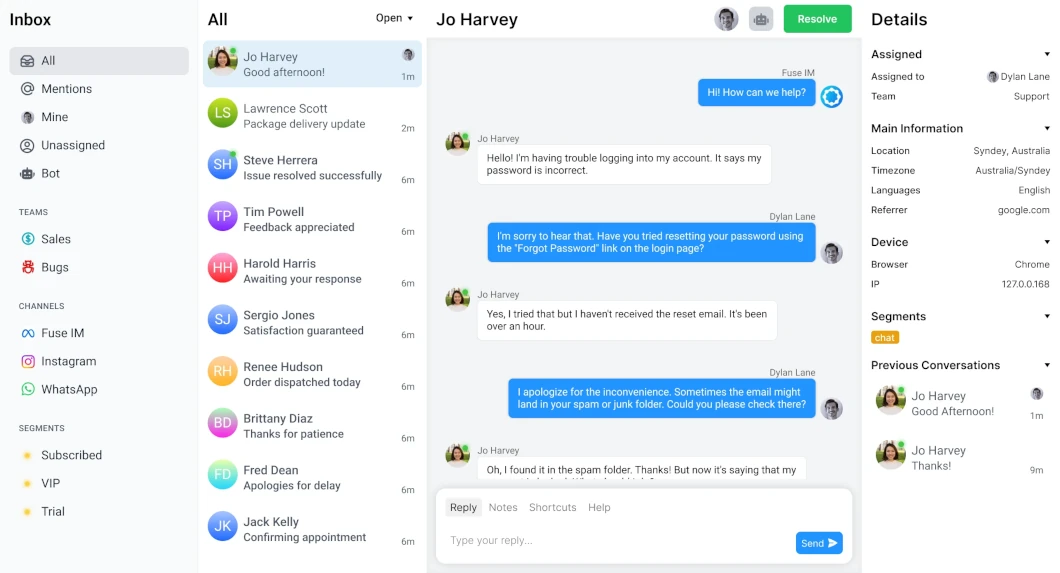An omnichannel chatbot is an AI-powered chatbot that provides a seamless and personalized customer support experience across multiple channels. It integrates with various communication platforms like websites, social media, and messaging apps to offer consistent support to customers wherever they are. Using an omnichannel chatbot, businesses can automate their customer service processes, improve efficiency, and enhance the overall customer experience.
Key Takeaways:
- An omnichannel chatbot offers seamless and personalized customer support across multiple channels.
- Integrating an omnichannel chatbot automates customer service processes and improves efficiency.
- Businesses can enhance the overall customer experience by implementing an omnichannel chatbot solution.
- Omnichannel chatbots help businesses stay competitive in the digital world and drive growth.
- Implementing an omnichannel customer service strategy and integrating a chatbot solution is essential for businesses.
The Benefits of Omnichannel Customer Service
Omnichannel customer service offers numerous benefits to businesses, allowing them to provide a seamless and personalized experience for their customers. Leveraging an automated messaging platform, businesses can enhance customer satisfaction and improve overall efficiency.
One of the biggest advantages of omnichannel customer service is the ability to resolve issues faster. Businesses can quickly address customer inquiries, leading to quicker problem resolution and increased customer satisfaction.
Comparison of Omnichannel Customer Service vs. Traditional Customer Service
| Benefits | Omnichannel Customer Service | Traditional Customer Service |
|---|---|---|
| Seamless Customer Experience | Yes | No |
| Personalized Support | Yes | Limited |
| Efficient Issue Resolution | Yes | Time-consuming |
Additionally, implementing an omnichannel customer service strategy can help businesses better identify opportunities to satisfy customers. Through data analysis and customer insights gathered from multiple channels, businesses can gain a deeper understanding of their customers' needs and preferences. This valuable information can be used to proactively address customer concerns, anticipate future needs, and ultimately drive customer loyalty.
Understanding Omnichannel vs. Multichannel Support
Omnichannel support and multichannel support are two approaches businesses use to provide customer service across different channels. While they both involve interacting with customers on multiple platforms, there are essential differences between them.
Omnichannel Support
Omnichannel support takes customer service to the next level by creating a seamless and personalized experience for customers across all channels. It enables customers to initiate a conversation on one channel and seamlessly continue it on another without losing context. All customer interactions, including conversation history and context, are stored and accessible to support agents, ensuring a consistent and efficient support experience.
Multichannel Support
On the other hand, multichannel support refers to businesses providing customer service through multiple channels without the integration and continuity that omnichannel support offers. While customers can reach out through different channels, their conversation history and context may not carry over, resulting in a fragmented support experience. Support agents may struggle to provide personalized assistance without access to the complete customer journey.
| Benefit | Omnichannel Support | Multichannel Support |
|---|---|---|
| Integration | Channels are integrated to maintain conversation history and context. | Channels operate independently, with limited integration. |
| Consistency | Provides a consistent support experience across all channels. | Support experience can vary across different channels. |
| Personalization | Enables personalized support based on customer history and context. | May lack personalization due to fragmented customer data. |
| Efficiency | Improves support efficiency by centralizing data and context. | Support agents may struggle to access complete customer journey. |
Implementing an Omnichannel Customer Service Strategy
Implementing an effective omnichannel customer service strategy is crucial for businesses looking to provide a seamless and personalized support experience across multiple channels. To achieve this, chatbot integration and the use of virtual assistants play a vital role. Consolidating all customer channels and context under a single source of truth streamlines support processes to deliver a unified customer experience.
Benefits of Chatbot Integration
Integrating a chatbot into your omnichannel customer service strategy offers a range of benefits. First and foremost, it enables businesses to provide 24/7 support, ensuring customers can access assistance whenever they need it. Also, chatbots can handle a high volume of inquiries simultaneously, improving efficiency and reducing customer wait times. Chatbots free up human agents to focus on more complex and value-adding interactions.
The Role of Virtual Assistants
Virtual assistants are another valuable tool for implementing an omnichannel customer service strategy. These AI-powered assistants can understand and respond to customer queries across different channels, seamlessly maintaining context and providing consistent support. Virtual assistants can also integrate with customer relationship management (CRM) systems to access relevant customer data, enabling them to deliver more personalized experiences.
| Key Considerations for Omnichannel Customer Service Strategy Implementation |
|---|
| 1. Consolidate customer communication channels and data into a centralized system. |
| 2. Choose a chatbot solution that supports integration with your existing systems and channels. |
| 3. Train your chatbot and virtual assistants to understand and respond accurately to customer inquiries. |
| 4. Regularly analyze and refine your omnichannel customer service strategy to align with customer preferences and needs. |
| 5. Monitor and measure key metrics, such as response time and customer satisfaction, to ensure the effectiveness of your strategy. |
Examples and Use Cases of Omnichannel Customer Service
Implementing an omnichannel customer service strategy can bring numerous benefits to businesses. Here are some examples and use cases that showcase the power of providing a seamless customer experience across multiple channels:
Example 1: Northmill Bank
Northmill Bank, a leading digital bank, successfully implemented omnichannel customer service to improve customer satisfaction. By providing consistent support across various channels such as their website, mobile app, and social media platforms, Northmill Bank ensured that customers could access assistance anytime, anywhere. This approach not only enhanced customer loyalty but also reduced response times, leading to higher customer satisfaction ratings.
Example 2: Real-Time Support
Many businesses leverage omnichannel chatbots to offer real-time support to their customers. These chatbots are integrated with multiple channels, including websites, social media, and messaging apps, allowing customers to reach out for assistance instantly. The chatbots can provide immediate responses, answer frequently asked questions, and even escalate complex issues to live agents if needed. This real-time support creates a sense of inclusivity and ensures that customers receive timely assistance, enhancing their overall experience.
Example 3: Personalized Customer Journeys
With an omnichannel customer service strategy, businesses can create personalized customer journeys that cater to individual preferences. By leveraging data collected from various channels, businesses can gather insights about customer preferences, past interactions, and purchase history. This information enables businesses to tailor their support interactions, recommend relevant products or services, and anticipate customer needs. The result is a personalized experience that strengthens customer relationships and drives loyalty.

Why Your Business Needs an Omnichannel Chatbot
When it comes to providing exceptional customer support and staying competitive in the digital world, having an omnichannel chatbot is essential. This AI-powered chatbot can revolutionize your customer service by offering a seamless and personalized experience across multiple channels.
An omnichannel chatbot enables you to enhance customer satisfaction by providing instant and accurate responses to their queries. It is available 24/7, ensuring that your customers can reach out to you at any time, without having to wait for a human agent to be available. This immediate support can significantly improve customer experience and create a positive impression of your brand.
One of the key benefits of an omnichannel chatbot is the valuable customer insights it provides. By analyzing customer interactions and preferences, you can gain a deeper understanding of their needs and preferences. This data can be used to personalize future interactions, create targeted marketing campaigns, and identify areas for improvement in your products or services.
Implementing an omnichannel chatbot solution also offers self-service options to customers. With the chatbot's ability to handle commonly asked questions and provide relevant information, customers can find answers to their queries without the need for human intervention. This self-service functionality not only saves time for both customers and support agents but also empowers customers to find solutions on their own terms.

Benefits of an Omnichannel Chatbot
| Benefits | Description |
|---|---|
| Enhanced customer satisfaction | Instant and accurate responses, available 24/7 |
| Valuable customer insights | Deep understanding of customer needs and preferences |
| Self-service options | Ability to handle commonly asked questions and provide relevant information |
| Elimination of redundancy | Efficient and consistent support across multiple channels |
| Revenue boost | Improved customer experience leads to increased sales |
Conclusion
An omnichannel chatbot is a game-changer for businesses in today's digital world. By integrating a support chatbot into your customer service strategy, you can automate processes, enhance efficiency, and deliver exceptional support across multiple channels. This customer service automation not only streamlines your operations but also ensures a seamless and personalized experience for your customers.
With an omnichannel chatbot, you can consolidate customer context and interactions under a single source of truth, eliminating duplication and redundancy. This allows you to provide consistent support and build stronger relationships with your customers.
Embracing an omnichannel chatbot is vital for businesses looking to meet the evolving needs of customers and stay ahead of the competition. It's a powerful tool that enables you to deliver exceptional customer service, enhance customer satisfaction, and drive growth. So, take the leap and unlock the full potential of an omnichannel chatbot for your business today.


